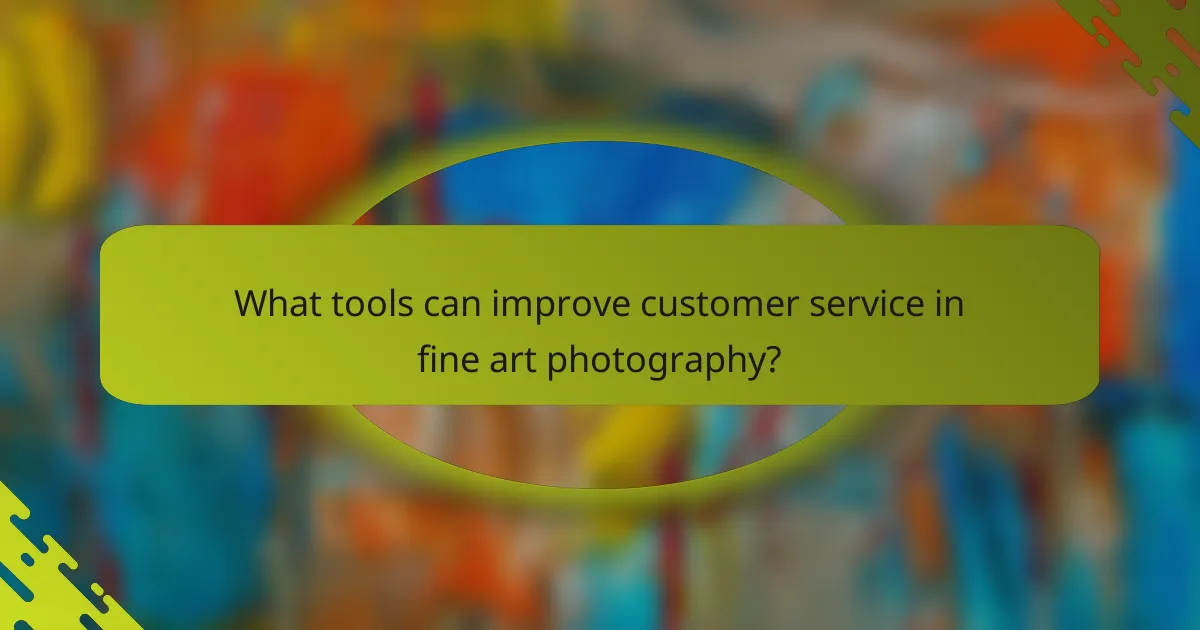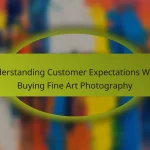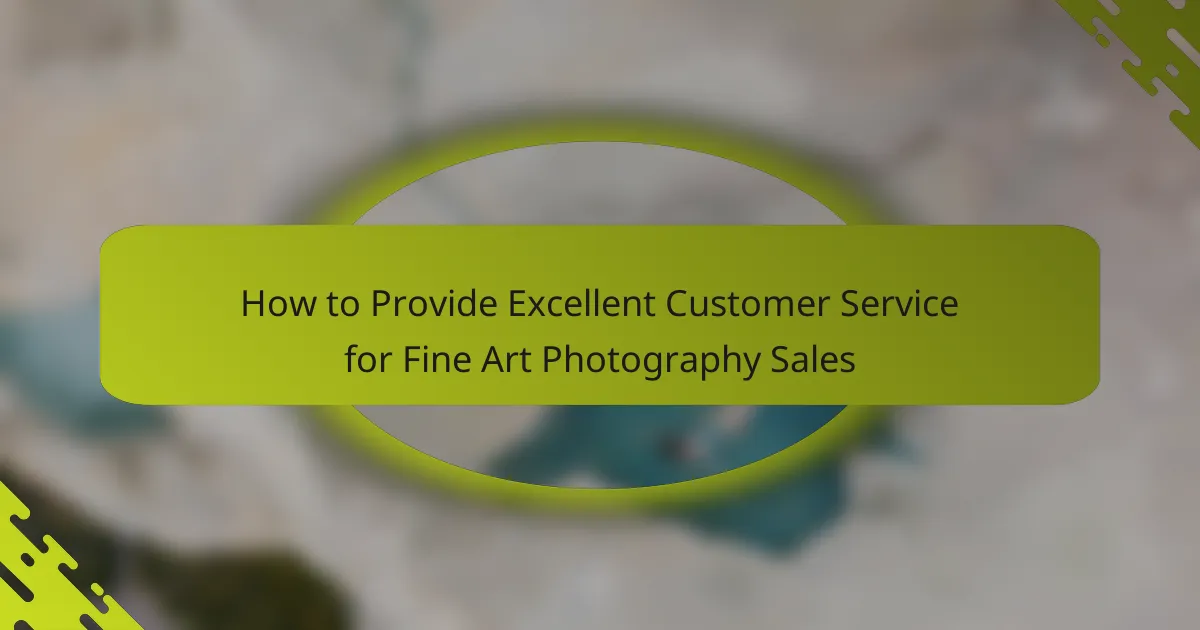Providing excellent customer service in fine art photography sales is essential for building lasting relationships with clients. By creating a personalized experience, ensuring prompt communication, and utilizing effective tools, you can enhance the buying journey and foster trust. These practices not only encourage repeat business but also generate valuable referrals.

How can you enhance customer service for fine art photography sales?
Enhancing customer service for fine art photography sales involves creating a personalized experience, ensuring prompt communication, and maintaining relationships post-purchase. These elements foster trust and satisfaction, encouraging repeat business and referrals.
Personalized communication
Personalized communication is key to making customers feel valued. Address clients by name and tailor your messages based on their interests or previous interactions. For instance, if a customer inquired about landscape photography, follow up with similar works or upcoming exhibitions that align with their preferences.
Utilize customer relationship management (CRM) tools to track interactions and preferences. This data allows you to craft targeted messages, enhancing the overall experience and increasing the likelihood of sales.
Timely responses to inquiries
Responding promptly to customer inquiries is crucial in maintaining engagement. Aim to reply within a few hours, ideally within one business day. Quick responses show that you value their time and are eager to assist.
Set up automated replies for common questions, but ensure that personalized follow-ups are made for more complex inquiries. This balance helps manage customer expectations while providing the attention they deserve.
Follow-up after purchase
Following up after a purchase is an effective way to reinforce customer satisfaction. Send a thank-you email shortly after the sale, expressing gratitude and inviting feedback on their experience. This gesture can significantly enhance customer loyalty.
Consider sending a follow-up message a few weeks later to check if they are satisfied with their artwork. You can also include care tips for the photography or suggest related pieces they might enjoy. This ongoing communication can lead to future sales and referrals.

What tools can improve customer service in fine art photography?
To enhance customer service in fine art photography sales, utilizing the right tools is essential. Effective tools streamline communication, manage inquiries, and maintain customer relationships, ultimately leading to a better buying experience.
Live chat software like Zendesk
Live chat software, such as Zendesk, allows for real-time communication with potential buyers. This tool can significantly reduce response times, enabling customers to get immediate answers to their questions about artworks, pricing, and availability.
When implementing live chat, ensure that your team is trained to handle inquiries efficiently. Consider setting up automated responses for common questions to further enhance the customer experience.
Email management tools such as Mailchimp
Email management tools like Mailchimp help in organizing and automating email communications with customers. These platforms enable you to send targeted newsletters, promotional offers, and updates about new artworks, keeping your audience engaged.
To maximize effectiveness, segment your email lists based on customer preferences and behaviors. This approach allows for personalized messaging, which can lead to higher engagement and conversion rates.
CRM systems like HubSpot
CRM systems, such as HubSpot, are vital for managing customer relationships and tracking interactions. These tools help you store customer information, monitor sales pipelines, and analyze customer data to improve service quality.
Utilizing a CRM can streamline follow-ups and ensure no customer inquiries are overlooked. Regularly update your CRM with customer feedback and purchase history to tailor your service and offerings effectively.

What are best practices for handling customer inquiries?
To provide excellent customer service in fine art photography sales, it’s crucial to respond promptly and accurately to customer inquiries. This builds trust and encourages potential buyers to engage with your offerings.
Use a dedicated FAQ section
A well-structured FAQ section can address common customer questions efficiently. This not only saves time for your staff but also empowers customers to find answers independently. Include topics such as shipping policies, return procedures, and payment options.
Regularly update the FAQ to reflect new products or changes in policies. Consider categorizing questions by themes to enhance navigation, making it easier for customers to locate the information they need.
Implement a ticketing system
A ticketing system streamlines the management of customer inquiries, ensuring that no question goes unanswered. This system allows you to track interactions, prioritize urgent requests, and maintain a record of customer communications.
Choose a ticketing solution that integrates well with your existing platforms. Look for features like automated responses for common queries and analytics tools to monitor response times and customer satisfaction.
Train staff on product knowledge
Well-informed staff can provide more effective assistance, enhancing the overall customer experience. Ensure your team is knowledgeable about the fine art photography you offer, including details about the artists, techniques, and materials used.
Regular training sessions can keep your staff updated on new products and industry trends. Encourage them to share insights with customers, which can foster a deeper connection and lead to increased sales.

How to manage customer feedback effectively?
Managing customer feedback effectively involves actively seeking input, analyzing responses, and implementing changes based on insights. This approach not only enhances customer satisfaction but also fosters loyalty and trust in your fine art photography business.
Encourage reviews on platforms like Google
Encouraging customers to leave reviews on platforms like Google can significantly boost your online visibility and credibility. After a purchase, send a follow-up email thanking them for their business and kindly request a review, making it easy by providing direct links.
Consider offering incentives, such as discounts on future purchases or entry into a giveaway, to motivate customers to share their experiences. Aim for a steady stream of reviews to create a balanced representation of your services.
Utilize feedback surveys post-purchase
Utilizing feedback surveys after a purchase allows you to gather specific insights about the customer experience. Keep surveys concise, focusing on key aspects such as product satisfaction, shipping speed, and overall service quality.
Implementing tools like Google Forms or SurveyMonkey can streamline this process. Aim for a response rate of around 20-30% by sending reminders and ensuring the survey is user-friendly.
Respond to feedback publicly
Responding to feedback publicly, whether positive or negative, demonstrates that you value customer opinions. Thank customers for positive reviews and address any concerns raised in negative feedback promptly and professionally.
This approach not only shows potential customers that you are engaged but also provides an opportunity to clarify misunderstandings and showcase your commitment to customer service. Aim to respond within 24-48 hours to maintain a positive brand image.

What are the key elements of a return policy for fine art photography?
A return policy for fine art photography should clearly outline the conditions under which customers can return purchased items. Key elements include guidelines on returns, the timeframe allowed for returns, and the condition requirements for the artwork upon return.
Clear guidelines on returns
Clear guidelines on returns help customers understand the process and avoid confusion. Specify whether returns are accepted for all purchases or only under certain conditions, such as defects or damage during shipping. Providing a straightforward step-by-step process for initiating a return can enhance customer satisfaction.
Consider including contact information for customer service, as well as any forms or documentation required to complete the return. This transparency builds trust and encourages customers to feel secure in their purchase.
Timeframe for returns
Establishing a clear timeframe for returns is essential to manage customer expectations. A common practice is to allow returns within 14 to 30 days from the date of delivery. This period gives customers ample time to evaluate their purchase while ensuring timely processing of returns.
Communicate any exceptions to the standard timeframe, such as holiday purchases or limited edition items that may have different return policies. This clarity can prevent misunderstandings and enhance the overall customer experience.
Condition requirements for returns
Condition requirements for returns specify the state in which the artwork must be returned to be eligible for a refund or exchange. Typically, fine art photography should be returned in its original packaging and without any signs of damage or wear. This ensures that the artwork can be resold without loss of value.
Consider outlining specific criteria, such as whether framed pieces can be returned if the frame is damaged or if the artwork must be in pristine condition. Providing examples can help customers understand what is acceptable and avoid potential disputes.

How can you create a memorable customer experience?
Creating a memorable customer experience in fine art photography sales involves personal touches and thoughtful presentation. By focusing on the details that reflect the value of the art, you can enhance customer satisfaction and encourage repeat business.
Offer packaging that reflects the art’s value
High-quality packaging is essential for fine art photography as it conveys the value of the artwork. Use sturdy, aesthetically pleasing materials that protect the art while enhancing its presentation. Consider options like custom boxes or eco-friendly packaging that aligns with your brand’s values.
Include elements such as tissue paper, protective sleeves, or even a branded seal to elevate the unboxing experience. This attention to detail can make a significant difference in how customers perceive their purchase.
Include personalized thank-you notes
A personalized thank-you note can leave a lasting impression on your customers. Handwritten notes expressing gratitude for their purchase not only show appreciation but also foster a personal connection. Mention specific details about the artwork they purchased to make the note feel unique.
Consider including a small offer or discount for future purchases in the note. This not only encourages repeat business but also makes customers feel valued and appreciated.
Provide exclusive access to new collections
Offering exclusive access to new collections can enhance the customer experience and build loyalty. Create a VIP list for customers who have made previous purchases, allowing them to preview and purchase new works before they are publicly available.
Promote this exclusivity through email newsletters or social media, emphasizing the benefits of being part of your inner circle. This strategy not only rewards loyal customers but also creates a sense of urgency and excitement around new releases.










